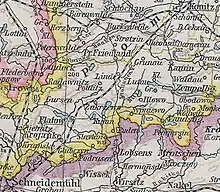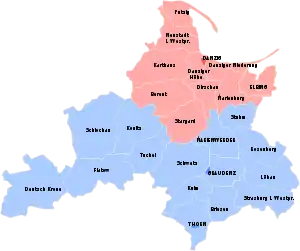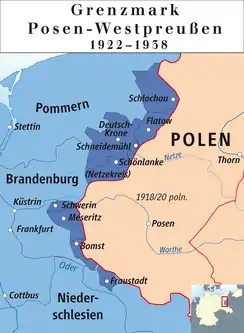Flatow (district)
The Flatow district was a district that existed in Prussia between 1818 and 1945. It belonged to the province of West Prussia until 1920. After World War I, the eastern portion of the district was ceded to Poland. The western portion of the district remained in Germany and became part of the Frontier March of Posen-West Prussia until 1938. The district then became part of the Province of Pomerania from 1938 to 1945. Today the territory of the Flatow district lies in the Kuyavian-Pomeranian Voivodeship and the Greater Poland Voivodeship in Poland.



History
The area of the Flatow district originally belonged to the Netze District, which was annexed by Prussia in the First Partition of Poland in 1772.[1] In 1815, the area around Flatow became part of Regierungsbezirk Marienwerder in the province of West Prussia. The Flatow district was founded on April 1, 1818. It consisted of the five towns Flatow, Kamin, Krojanke, Vandsburg and Zempelburg.[2] The capital of the district was the town of Flatow.
From 1829 to 1878, West Prussia and East Prussia were united to form the Province of Prussia, which belonged to the German Empire from 1871.
After World War I, when the Treaty of Versailles came into force on January 10, 1920, the eastern part of the Flatow district with the cities of Vandsburg, Zempelburg and Kamin was ceded to Poland without a referendum for the purpose of establishing the Polish Corridor. 30,516 people lived there, of whom 8,600 were Poles. On July 1, 1922, the new province of Grenzmark Posen-West Prussia was formed. On October 1, 1938, the Flatow district was incorporated into the Province of Pomerania after the Posen-West Prussia province was dissolved.
In the spring of 1945, the Flatow district was occupied by the Red Army. After the end of World War II, the district was placed under Polish administration in accordance with the Potsdam Agreement. In the following years the German population of the district was expelled and replaced by Poles.
Demographics
| 1837 | 1852 | 1855 | 1858 | |||||
|---|---|---|---|---|---|---|---|---|
| Germans | 27,283 | 69.53% | 38,139 | 72.29% | 39,318 | 72.61% | 41,115 | 73.25% |
| Poles | 11,956 | 30.47% | 14,622 | 27.71% | 14,830 | 27.39% | 15,016 | 26.75% |
| Total | 39,239 | 52,761 | 54,148 | 56,131 | ||||
Place Names
In the course of the 20th century, many place names in the district which were considered "not German" enough were given a phonetic alignment or translation:
- Augustowo → Augustendorf, 1914
- Cziskowo → Ziskau, 1912
- Dollnik → Wittenburg, 1926
- Glubschin → Steinau, 1926
- Hüttenbusch → Wilhelmsbruch, 1928
- Klukowo → Blankenfelde, 1928
- Leßnick → Lessendorf, 1926
- Obodowo → Obendorf, 1908
- Ossowke → Espenhagen, 1926
- Ossowo → Aspenau, 1926
- Paruschke → Treuenheide, 1926
- Petzewo → Deutsch Fier, 1926
- Podrusen → Preußenfeld, 1927
- Polnisch Wisniewke → Lugetal, 1913
- Skietz → Kietz, 1926
- Slawianowo → Steinmark, 1939
- Smirdowo bei Flatow → Schmirdau, 1909
- Smirdowo bei Krojanke → Schmirtenau, 1909
- Wersk → Seedorf, 1926
- Zakrzewke → Seemark, 1907
- Zakrzewo → Buschdorf, 1935
References
- Herzberg, Friedrich (1790). Kurzer abriss der geographie der königlich-preussischen staaten: besonders zum gebrauch in vaterländischen schulen (in German).
- Töppen, Max (1858). Historisch-comparative Geographie von Preussen: Nach den Quellen, Namentlich auch Archivalischen (in German). J. Perthes.
- Belzyt, Leszek (1998). Sprachliche Minderheiten im preussischen Staat: 1815 - 1914 ; die preußische Sprachenstatistik in Bearbeitung und Kommentar. Marburg: Herder-Inst. ISBN 978-3-87969-267-5.